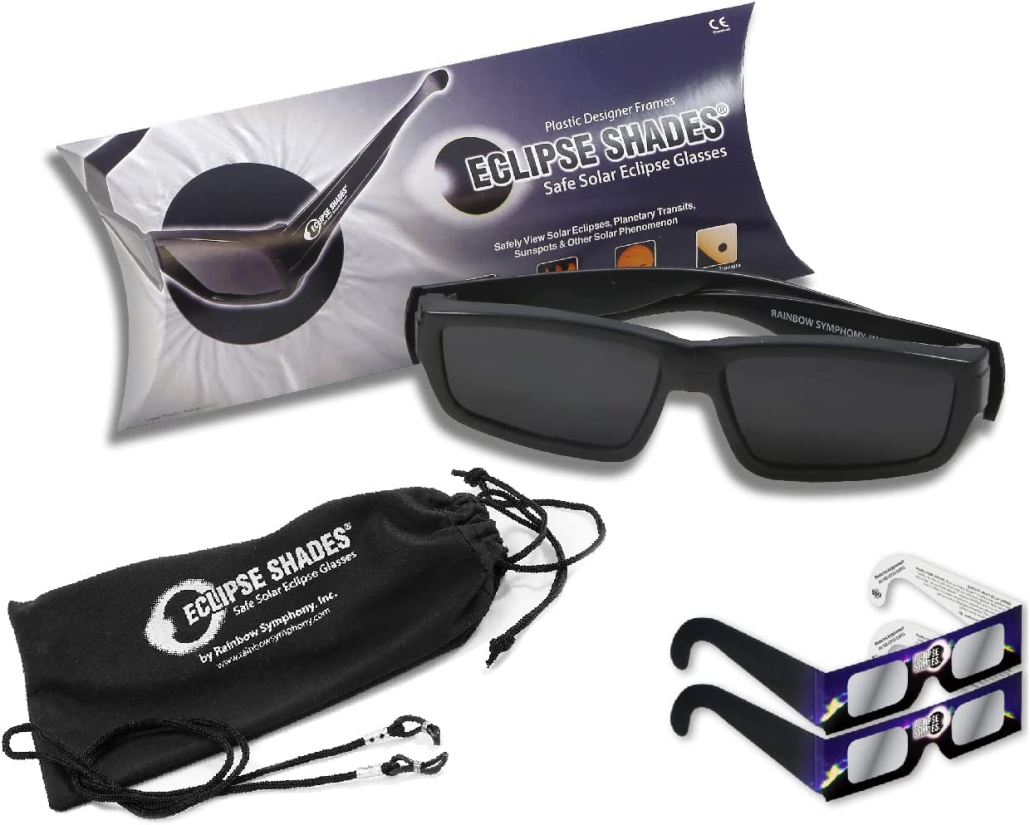Eclipse Eye Safety
Looking directly at the sun is unsafe except during the brief total phase of a solar eclipse (“totality”), when the moon entirely blocks the sun’s bright face, which will happen only within the narrow path of totality.
- Always inspect your solar filter before use; if scratched or damaged, discard it. Read and follow any instructions printed on or packaged with the filter. Always supervise children using solar filters.
- Stand still and cover your eyes with your eclipse glasses or solar viewer before looking up at the bright sun. After glancing at the sun, turn away and remove your filter — do not remove it while looking at the sun.
- Do not look at the uneclipsed or partially eclipsed sun through an unfiltered camera, telescope, binoculars, or other optical device. Similarly, do not look at the sun through a camera, a telescope, binoculars, or any other optical device while using your eclipse glasses or hand-held solar viewer — the concentrated solar rays will damage the filter and enter your eye(s), causing serious injury. Seek expert advice from an astronomer before using a solar filter with a camera, a telescope, binoculars, or any other optical device.
- If you are within the path of totality, remove your solar filter only when the moon completely covers the sun’s bright face and it suddenly gets quite dark. Experience totality, then, as soon as the bright sun begins to reappear, replace your solar viewer to glance at the remaining partial phases.
An alternative method for safe viewing of the partially eclipsed sun is pinhole projection. For example, cross the outstretched, slightly open fingers of one hand over the outstretched, slightly open fingers of the other. With your back to the sun, look at your hands’ shadow on the ground. The little spaces between your fingers will project a grid of small images on the ground, showing the sun as a crescent during the partial phases of the eclipse.
A solar eclipse is one of nature’s grandest spectacles. By following these simple rules, you can safely enjoy the view and be rewarded with memories to last a lifetime.
This document does not constitute medical advice. Readers with questions should contact a qualified eye-care professional.
Beyond basic eclipse glasses
If you want to get the very best views of this rare event, there are an assortment of products ideal for viewing a solar eclipse, including glass and safety film solar filters for telescopes and binoculars as well as specialized telescopes, filters, and finder scopes designed for optimal solar viewing.
CAUTION: Never look at the Sun, either directly or through a telescope or binocular, without a professionally made protective solar filter installed that completely covers the front of the instrument, or permanent eye damage could result. When using a truss tube telescope to view the Sun, both a properly fitting solar filter and light shroud are required.
Get your eclipse shades now
Additional Safety Information
An eclipse is a rare and striking phenomenon you won’t want to miss, but you must carefully follow safety procedures. Don’t let the requisite warnings scare you away from witnessing this singular spectacle! You can experience the eclipse safely, but it is vital that you protect your eyes at all times with the proper solar filters. No matter what recommended technique you use, do not stare continuously at the sun. Take breaks and give your eyes a rest! Do not use sunglasses: they don’t offer your eyes sufficient protection. One excellent resource for safe solar eclipse viewing is here: http://www.nasa.gov/content/eye-safety-during-a-total-solar-eclipse
Viewing with Protection — Experts suggests that one widely available filter for safe solar viewing is number 14 welder’s glass. It is imperative that the welding hood houses a #14 or darker filter. Do not view through any welding glass if you do not know or cannot discern its shade number. Be advised that arc welders typically use glass with a shade much less than the necessary #14. A welding glass that permits you to see the landscape is not safe. Inexpensive eclipse glasses have special safety filters that appear similar to sunglasses, but these do permit safe viewing.
Telescopes with Solar Filters – Eclipses are best viewed directly when magnified, which means a telescope with a solar filter or solar telescopes. These will give you a magnified view that will clearly show the progress of an eclipse. Never look through a telescope without a solar filter on the large end of the scope. And never use small solar filters that attach to the eyepiece (as found in some older, cheaper telescopes.)
Pinhole projectors(link is external) — Pinhole projectors and other projection techniques are a safe, indirect viewing technique for observing an image of the sun. These provide a popular way for viewing solar eclipses.
Related projection methods — One viewing technique is to project an image of the Sun onto a white surface with a projecting telescope. This is explained further here: http://www.astrosociety.org/education/publications/tnl/05/stars2.html(link is external).
The Exploratorium demonstrates how to view a planet in transit or an eclipse safely by projecting the image with binoculars: projecting the image with binoculars: http://www.exploratorium.edu/transit/how.html(link is external). There are commercially available projection telescopes as well.
Personal Safety Information
Besides eye protection during solar eclipse viewing, one needs to pay attention to their personal needs and surrounding. Below are some additional safety tips for eclipse observers before, during and after the April 8, 2024 solar eclipse.
Car Safety
Planning to Drive the Eclipse
https://www.ready.gov/car
Camping Health and Safety
https://www.cdc.gov/family/camping/
http://www.recreation.gov/recFacilityActivitiesHomeAction.do?goto=camping.htm&activities=9
Hiking Safety
Heat and Children in Cars
http://www.safercar.gov/parents/InandAroundtheCar/heatstroke.htm
http://www.safercar.gov/parents/InandAroundtheCar/heat-involved.html
Federal Emergency Management Agency
Food and Water Safety
Hazards to Outdoors Workers
Heat and Hydration


